Lawn Care - General Advice
A beautiful lawn is at the heart of any garden. When it looks lush and green, it's the perfect complement to colourful beds and borders, whilst if it looks tired and drab it can significantly detract from the appearance of your home. Looking after your lawn is one of the most intensive and time consuming areas of maintenance in a garden, but indulging your lawn with the correct care will pay dividends. Lawn care doesn't have to be complicated - you must just be prepared to take simple steps and tackle problems early before they get worse. The tips in this article will help you get started.
Watering
Watering should in theory be the most straightforward of maintenance tasks for your lawn, but in fact it is often done wrong, leading to a weakening in the lawn's drought resistance and general health. The first important rule is to only water when the lawn desperately needs it, not according to an arbitrary plan. Watering is only in order when the soil becomes completely dry, but before the grass looses its 'springiness', starts to look flat and adopts a dull, silvery blue tinge. In practice, even grass that's started to yellow can normally be recovered following a good water, but if your lawn has turned brown it's probably too far gone and removing what's left of your lawn / completely reseeding is probably the best option.
Aerate the ground before watering to assist water penetration if the surface of your lawn is very hard. When watering, do so very thoroughly, ensuring that the moisture reaches right through to the base of the roots. Doing a frequent, quick, light water is actually counter-productive because it encourages roots to develop only at the surface not further down, which minimises the lawn's future access to water leaving it vulnerable to drought damage. Water at least half an inch into the ground for clay soils or an inch for sandy soils. See our How to Prepare your Soil article for help in determining your soil type. You can work this out by placing a few straight sided containers (empty paint tins are ideal) in the sprinkler area to catch some water. If you time the process until there is the required amount of water in the container you’ll know how long to water for.
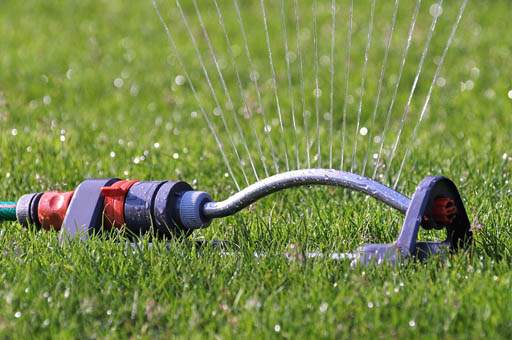
The best time to water your lawn is during cooler times of the day, so evaporation is minimised and more moisture soaks into the lawn. Some lawn experts suggest that having wet grass at night can promote disease, so early in the morning is ideal. Be sure to observe any local regulations or hosepipe bans that are in force.
Weeding
Weeds will grow anywhere given the opportunity and quickly invade wherever space permits and there are suitable conditions. Unfortunately, this also includes any thin or weak areas in your lawn. Make your lawn a strong competitor against weeds by sticking to a good lawn maintenance program, feeding your lawn regularly (about 4 times a year) and being careful not to mow too short.
Spot-treating weeds in your lawn using a spray lawn weed killer is an option if only a few of them have made it through and the problem is not endemic. Use a hand trowel, hand fork or daisy grubber to remove weeds such as thistles, dandelions, daisies and plantains, along with their tap roots. If weeds are more widespread, using a lawn weed killer is usually the more effective option. Do not use a general purpose weed killer on your entire lawn as this will kill your grass also - a specific lawn weed killer must be used because this will tackle the weeds whilst leaving your lawn untouched. Some smaller-leaved weeds and not easily controlled using lawn weed killer. Lawn weed killer is specially designed not to harm anything that's narrow-leaved, mainly grass, but the slight drawback this brings is that there are a small number of narrow-leaved weeds such as black medick and trefoil that it does not kill either. Tackle these selectively using a normal spray weed killer. Simply spray on and they will wilt and die in just a few weeks.
The best time to tackle weeds using a lawn weed killer is in spring or summer when your lawn and the weeds are growing most quickly. The only caveat here is to avoid application during the height of the summer as the lawn will be fighting to cope with the heat, so application of chemicals at this time is not recommended. Many people find that using. In very severe cases of weed infestation where it seems unlikely the lawn will be restored to any sort of quality after the weeds have been extracted, it's probably best to remove the existing lawn altogether and re-apply lawn seed afresh, making sure that the weed problem is resolved before you start. Autumn is the best time to do this as many weeds are already dead late in the season so there is less competition for space as the grass seed takes root.a lawn feed, weed and moss killer to feed the lawn and tackle weeds in one go is a time-saving option.
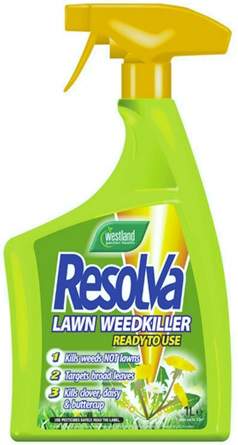
Moss
Moss comprises of a group of primitive non-flowering plants that form a spongy mass and spread quickly on undisturbed soil. Different gardens have different tolerances to moss but if you have moss spores in your lawn it will only get worse and is worth rectifying sooner rather than later. It can become a serious problem during the spring and autumn amongst sections of your lawn that lie in the shade and have poor nutrition and drainage. Lawns which have been compacted and which lack organic matter are also particularly vulnerable. Moss can easily be killed with a multi-purpose grass feed, weed and moss killer, however, unless the conditions that led to the moss developing are changed, it will return again from the spores on the soil surface. Make sure you remove the causes by spiking to improve drainage and, for shaded areas, over-seeding with a grass seed for shade mix to improve the vigour of the lawn.
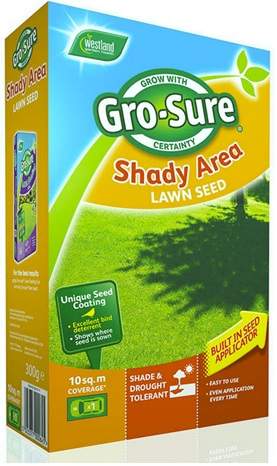
Feeding
Feeding is an essential part of maintaining a healthy lawn, particularly during periods of warm weather when nutrients in the soil are used up more rapidly by fast grass growth. Without extra nutrients grass soon uses up plant food reserves in the soil and then turns pale and thin. Feeding makes the grass greener, thicker and stronger so it is better able to compete with weeds, moss and weather-related stresses.
Feed your lawn every 6 weeks during the spring and summer (4 times in total) using a slow-release granular feed that will deliver a steady supply of nutrients over several weeks. If you prefer to adopt an organic alternative approach, use chicken manure pellets. Always rake away any debris and fallen leaves from your lawn before feeding and do not feed in August as this will foster leafy growth that will be more vulnerable to winter frosts.
Be careful to ensure feed is applied evenly over the whole lawn at the recommended rate. Under application will mean your chosen lawn product does not have the desired effect; whilst, even worse, over-application can lead to burning and damage to the grass. If you have a large lawn, you'll find it quicker and more accurate to apply feed granules using a wheeled spreader. Spreaders are typically adjustable, normally with a 45cm spreading width so you can easily and accurately apply your selected lawn product.
If applied regularly throughout the spring/summer, including a generous final feed at the end of summer, a high potassium lawn feed will strengthen the grass, preparing it for the rigours of winter and leaving you better placed to have a high quality lawn the following spring. If the weather is hot and dry you’ll need to water your lawn after you’ve fed it to activate the feed however, if the weather is cooler or rainy you can leave it be.
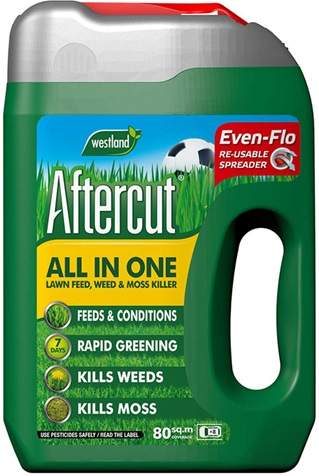
Scarifying
Scarifying means using a lawn rake to remove dead grass, thatch and other debris from your lawn that both looks unsightly and prevents health grass growth. As a minimum, scarify at the start of the season in March/April, then again as the leaves fall from the trees in autumn and once again in November. If fallen leaves are a problem in your garden, try to remove them from the lawn as regularly as possible (at least weekly). Do not be tempted to wait until all leaves have fallen to allow you to do a single tidy-up, as this will leave your lawn struggling under a dark, cold blanket of rotting vegetation.
Scarifying should also be done every time you mow your lawn, unless you are using a grass box to collect the clippings. Check for and treat moss infestation before scarifying. If you don’t treat the moss with a suitable lawn moss-killer before raking it out, you may inadvertently spread the spores around the lawn and make the problem worse. Moss is most likely to appear in your lawn after the autumn rains have soaked your soil.
Aerating
Compaction is one of the biggest problems with lawns. Without air spaces the soil is unable to hold air or water thus producing a lifeless unhealthy lawn. Aerating improves drainage, reduces water logging problems and helps your lawn grow thicker and stronger. Sections of grass around the clothes line, near the kids play area and next to the patio are generally in most need of aeration and if you have a soil that gets water-logged easily or stays permanently wet, the task is even more important.
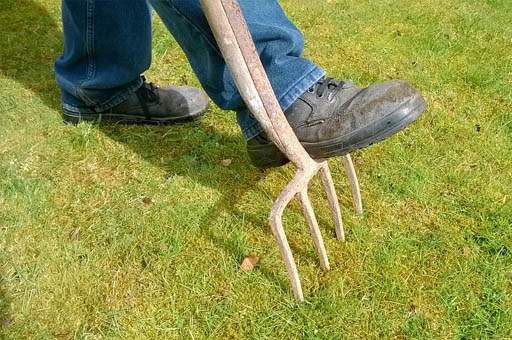
Aeration should be done in spring and autumn using a garden fork or hollow-tined aerator. Simply drive your fork or aerator into the ground as deep as possible at 15cm (6 inch) intervals across your entire lawn. This will allow rain and air to penetrate more deeply and eliminate compaction. A hollow-tine fork is ideal because it takes out several plugs of earth to a depth of 4 inches. Fill the holes left with compost. This will be pulled into the ground by worms, improving the composition of your soil.
Share this page:
